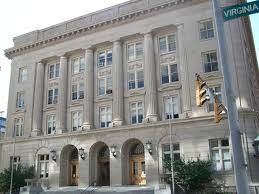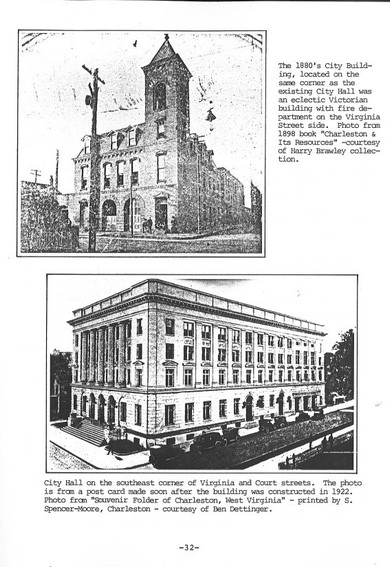Charleston City Hall
Introduction
Text-to-speech Audio
Images
Charleston's City Hall was completed in 1922 at a cost of $650,000

Charleston City Hall: Past and Present

Backstory and Context
Text-to-speech Audio
After the Civil War, an engine house was constructed on the courthouse property and housed Charleston city offices on the second floor. The engine house burned down in 1874, and for the next ten years all city offices, including the mayor’s, were located in rented rooms throughout Downtown Charleston. The first official City Hall building was constructed in 1884 for $13,000. The first floor of the 1884 City Hall housed the fire department and a lock-up, while the second floor housed city offices, and the third floor was utilized as a storage area. Due to the growing population of Charleston after becoming the permanent West Virginia State Capital, over 30,000 people from 1900 to 1922, there was a need for a new facility to house city matters.
When the new Charleston City Hall was completed in 1922, it was remarked as, “the finest municipal building in the south.”1 The new city hall cost $650,000, which was considered expensive for the time period. A local West Virginia architect, H. Rus Warne was hired to design the new city hall, while A.G. Higgenbotham was responsible for its construction. Bonner H. Hill was the Charleston City Manager at the time of construction, and later went on to become the secretary of the West Virginia Captiol Building Commission; Hill was noted as being very involved in supervising both projects. On August 31st, 1922, one third of Charleston’s population showed up to tour the new facility; Mayor Hall, H. Rus Warne, A.G. Higginbotham, and Bonner H. Hill were all in attendance. The fourth floor of Charleston City Hall was originally utilized as health care center, which was a new concept for the growing city.
“But the new thing, the one with which Charleston people are not familiar, is the provision made for caring for the physically ailing or the delinquents of life. Here the paternal aspect of the whole thing was best exemplified. Here it has been shown how a city is not indifferent to derelict who is sick, the wayward who needs restraint and medical attention, the casual emergency case that needs treatment and care and all done at the expenses of the city.” –Charleston Gazette reporting on the grand opening of the new Charleston City Hall.1
The Charleston City Hall building was constructed to outlast the population boom of the state capital, and has proven to be true.
Sources
1. Brighton, Paul D.. Cook, John D.. Historical and Architectural Survey Downtown Charleston, West Virginia.Charleston, WV. Charleston Regional Chamber of Commerce and Development, 1984.
National Register of Historic Places Nomination Form, Kanawha County Courthouse. West Virginia History and Culture website. Accessed December 30, 2016. http://www.wvculture.org/shpo/nr/pdf/kanawha/78002801.pdf.
Peyton, Billy Joe. Then & Now: Charleston. Charleston, SC. Arcadia Publising, 2010.
Charleston: A Capital Experience. Atlanta, Georgia. Riverbend Books, 2000.
Rice, Otis K. Charleston and the Kanawha Valley. Windsor Publications, Inc, 1981.
Morgan, John G. Charleston 175. Charleston, WV. The Charleston Gazette, 1970.
Laidley, W. S. History of Charleston and Kanawha County West Virginia and Representative Citizens. Chicago, IL. Richmond-Arnold Publishing Co.
